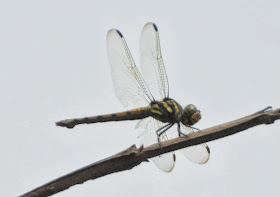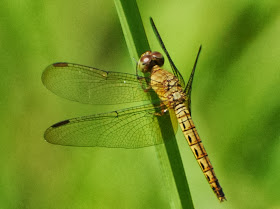To
follow the gallery of damselflies from my September 2012 visit to
Merapoh, at the western end of Taman Negara National Park, here is a
series of dragonflies. We'll start with another of Malaysia's confusing
but attractive red-bodied dragons, this one a species new to me
(assuming I have identified it correctly!): Aethriamantina brevipennis, a rather small and stubby insect compared with the rather similar Orthetrum spp. It is apparently a haunter of forest edge near rivers - a perfect description of our site at Merapoh.
The two species of Cratilla
are much more closed-forest inhabitants than the previous species,
preferring to breed in small wooded ponds. They are both gorgeous,
strikingly metallic insects. Cratilla metallica, an insect I see
frequently in Borneo, has dark wing-tips. This is a male, with a
chalky blue patch near the base of the abdomen (on segments 2-4).
Cratilla lineata, which is otherwise similar, lacks the dark tips to the wings, making it quite easy to tell the two species apart.
I found this fine-looking gomphid along the edge of the road in the park. It appears to be another forest species, Gomphidictinus perakensis.
Notice the almost completely black abdomen In these photographs you
can just see another distinguishing mark: the yellow "boomerang-shaped"
mark (or antehumeral stripe) on the shoulder is broken at the top (in a similar species, Gomphidia kruegeri, the mark is solid).
I tried to get close for more diagnostic shots, but the dragonfly was overhead and not at the best angle.
A
short time later I returned to find what I thought was the same insect
sitting nicely in the open - but instead it turned out to be the common
and widespread open-country species Ictinogomphus decoratus (notice the yellow markings along the abdomen and the broad abdominal flanges).
This
yellow thoracic stripes on this dragonfly had me thinking that I had
found still another gomphid, until I got a better look and made out the
oversize, joined-together compound eyes (quite unlike the
broadly-separated eyes of the Gomphidae). It is, instead, another
libellulid, a female Potamarcha congener. I never did see the blue-and-yellow male, which must be a magnificent insect.
Common open-country dragonflies like this female Neurothemis fluctuans dominated the area where we were staying, across the river from the forest proper.
There were numbers of Orthetrum dragonflies about, including Orthetrum chrysis (males look almost translucent in the right light).
Female Orthetrum
can be very difficult to identify to species, as aging individuals tend
to turn dull greenish no matter what species they belong to. I'm not
sure which these are.
The reddish tip to the abdomen suggests that this may be Orthetrum chrysis.
These individuals, however, show signs of bluish pruinescence, making it more likely that they are Orthetrum glaucum.
The bluer they get, the easier they are to place; these are probably Orthetrum glaucum too.
One
afternoon, while relaxing with a cup of tea outside our rooms, I
noticed a pair of dragonflies "in wheel" high overhead. Rather to my
astonishment, I managed to get an identifiable photo - they were Pantala flavescens, the Wandering Glider,
the most widespread migratory dragonfly in the world. Notice the very
broad hindwings, and the brownish spot at the tip of the hindwing in the
male (the one to the right, with the tip of his abdomen locked behind
the female's head as she reaches forward for his sperm packet).
Dragonfly-watching
is usually a daytime activity, but as dusk fell at Merapoh drainage
ditches around the park entrance were invaded by the ghostly forms of Zyxomma obtusum.
These are males; the brown-bodied, green-eyed female is very
different. This is not an easy dragonfly to photograph - so although
these aren't ideal portraits, I am quite happy to cue a sunset metaphor,
and end my Merapoh dragonfly gallery here.
























No comments:
Post a Comment